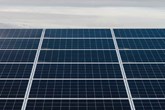Atlas Copco provides critical power supply for the installation of world's first 16 MW wind turbine
Published by Jessica Casey,
Editor
Energy Global,
Atlas Copco has supplied a QES 60 power generator for the successful installation of the world’s first 16-MW offshore wind turbine, in southeast China's Fujian Province. Atlas Copco's partner in the region, Chengdu Shiwei Technology Corp., delivered this reliable QES power generator to provide the critical power supply needed for the spreader to install the three large turbine blades.
According to the National Bureau of Statistics, in 1H23, China’s total generated power reached 4.17 trillion kWh, up 3.8% y/y, with wind power increasing 16% y/y.
As part of the country’s commitment to sustainability, China has invested in and built the world's largest offshore wind farm in terms of single-unit capacity, in the Fujian province. The wind farm, which is located approximately 35 km offshore from Pingtan, consists of 11 offshore wind turbine units, including the world's largest 16-MW offshore wind turbine unit. The total installed capacity of the wind farm reaches 111 MW.
The 16-MW offshore wind turbine is 152 m high and includes the world’s longest turbine blades at 123 m, and each blade weighs 54 t. The total swept area of the three blades is approximately 50 000 m2, which is equivalent to the area of seven standard-sized football fields.
At full wind speed, the wind turbine can generate 34.2 kWh of power after one full rotation. Its annual power output is estimated to average over 66 million kWh and is expected to meet the annual demand of 36 000 three-person families, saving 22 000 t of standard coal, and reducing 54 000 t of carbon dioxide.
The installation was facilitated by China’s most advanced self-lifting and self-propelled integrated wind power installation platform Baihetan, with a lifting capacity of 2000 t. However, the installation of such a large turbine was no easy feat, and the turbine’s vast size caused significant challenges.
The altitude and the marine environment also made this project extremely complex. Additionally, the wind-exposed surface area of the turbine increases with each blade added. As a result, the third blade had to be installed in one operation without interruption to ensure the overall stability of the structure. This required particular demands from the generator.
“The humidity and salty sea air could easily corrode the machines, so the equipment needed to be able to withstand these conditions,” said Winston Wang, Product Specialist Power & Light at Atlas Copco in Shanghai. “Additionally, the blades were docked at a height of 100 m, and working at such a high altitude required equipment with a remote-control function. Finally, in this application, downtime would represent a huge loss, and the stability and durability of the generators were essential.”
Chengdu Shiwei Technology Corporation recommended Atlas Copco’s QES 60 power generator as they knew it would be able to operate reliably in these challenging conditions. The QES 60 was ideal for the application as it can withstand harsh elements and is equipped with a remote operation and monitoring system. Operators can instruct the unit from a distant platform, monitoring the generators' performance and overseeing the process remotely.
The QES 60 power generator was also modified slightly to meet the customer’s specific needs.
“This QES generator set was specially designed with a large capacity tank so that it could work continuously for more than 24 hours without fail, therefore providing the reliability and stability needed,” explained Wang. “Additionally, the waterproof canopy underwent a C5M coating and painting process to provide higher corrosion resistance compared to conventional models. The generator was also equipped with an anti-condensation heater to improve the anticorrosion and moisture resistance of the electrical core components.”
The installation of the vast offshore wind farm marks a breakthrough in high-end wind turbine manufacturing and deep-sea offshore wind power construction capabilities.
“The effective setup and utilisation of the wind turbine represents a significant achievement in advancing China's offshore wind power industry toward extensive offshore innovation,” commented Fangjian Xie, Project Manager at Chengdu Shiwei Technology Corp.
Globally, installed offshore wind capacity reached 63.2 GW by the end of 1H23, 45% of which (28.7 GW) is now installed in China, according to the annual report published by industry body World Forum Offshore Wind (WFO). Furthermore, the country provides nearly 60% of global wind turbine equipment. China’s growth continues, with 2.2 GW of newly installed capacity during 1H23.
“The 16-MW offshore wind turbine is expected to boost the development of China’s offshore wind power industry even further, and Atlas Copco is proud to be contributing towards the optimisation of renewable energy usage,” concluded Wang.
For more news and technical articles from the global renewable industry, read the latest issue of Energy Global magazine.
Energy Global's Winter 2023 issue
The Winter 2023 issue of Energy Global hosts an array of technical articles weather analysis, geothermal solutions, energy storage technology, and more. This issue also features a regional report looking at the future of renewables in North America, and a report from Théodore Reed-Martin, Editorial Assistant, Energy Global, on how Iceland utilises its unique geology for renewable energy.
Read the article online at: https://www.energyglobal.com/wind/13022024/atlas-copco-provides-critical-power-supply-for-the-installation-of-worlds-first-16-mw-wind-turbine/?yptr=yahoo
You might also like
ACCIONA Energía to build two new photovoltaic plants in Italy
ACCIONA Energía to build two new photovoltaic plants in Italy after securing 151 MW in public auction.

